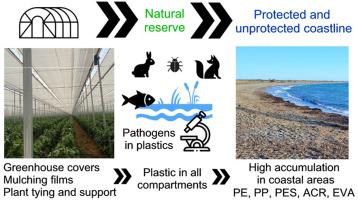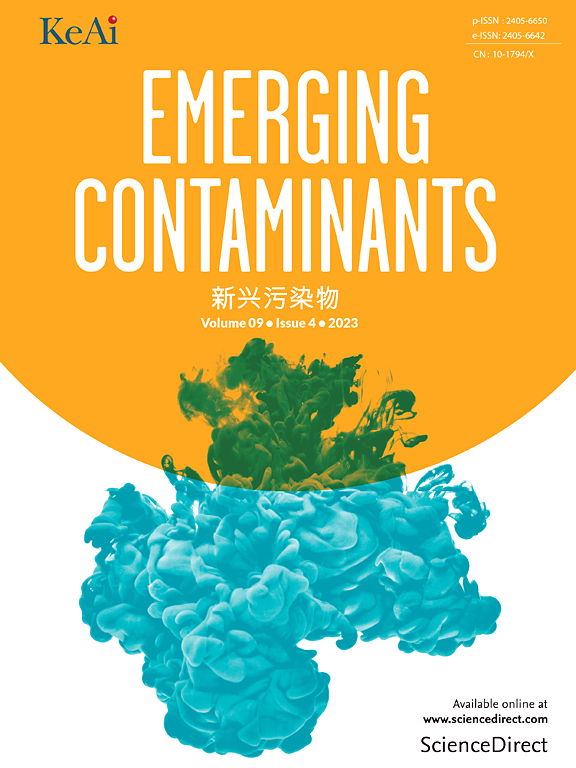温室之外:来自集约化农业地区的塑料污染蔓延
IF 6.9
2区 环境科学与生态学
Q1 ENVIRONMENTAL SCIENCES
引用次数: 0
摘要
在塑料污染的众多来源中,温室农业是一个主要的贡献者,因为它大量使用塑料材料。这项研究调查了世界主要温室种植区之一的塑料垃圾。这项研究包括非生物(土壤、淡水、海水和空气)和生物隔间(无脊椎动物、食草动物、鱼类和捕食者),以及细菌和真菌病原体在农业塑料上的存在。在包括近岸海水在内的所有取样隔间中都发现了塑料。沿海岸线记录的浓度最高,在那里发现了代表15种不同聚合物的1397件塑料制品,中位数浓度为1.92(1.73-2.13)件/m2或3.05 (2.29-3.81)g/m2,边界代表四分位数范围。在所有隔间中发现的大多数聚合物在形态、类型和颜色方面与农业操作中发现的聚合物相匹配。值得注意的是,保护区出现了高浓度的塑料,这表明仅靠法律保护并不能防止污染。温室塑料在温室区域附近的保护区尤其普遍,而不是在附近的城市区域,这可以解释为农业开发的邻近。我们估计,大约有290公斤的塑料,包括80公斤的聚乙烯,散落在沿海地区,这个数字约占生产区每年产生的塑料废物的十分之一。我们的研究结果还表明,农用塑料废弃物可能是细菌和真菌病原体的载体和储存库,甚至可以促进它们在受保护的环境中传播。本文章由计算机程序翻译,如有差异,请以英文原文为准。

Beyond the greenhouse: The spread of plastic pollution from an intensively cultivated agricultural area
Among the many sources of plastic contamination, greenhouse agriculture is a major contributor due to its intensive use of plastic materials. This study examines plastic waste in one of the world's leading greenhouse farming regions. The research included both abiotic (soil, freshwater, seawater, and air) and biotic compartments (invertebrates, herbivores, fish and predators) as well as the presence of bacterial and fungal pathogens colonizing agricultural plastics. Plastics were identified in all sampled compartments, including the nearshore seawater. The highest concentrations were recorded along the coastline, where 1397 plastic items representing 15 different polymers were found with a median concentration of 1.92 (1.73–2.13) items/m2 or 3.05 (2.29–3.81) g/m2, the boundaries representing interquartile ranges. Most of the polymers identified across all compartments matched those found in agricultural operations in terms of morphology, type, and colour. Notably, high plastic concentration appeared in protected areas, indicating that legal protection alone does not prevent pollution. Greenhouse plastics were especially prevalent in the protected zones near the greenhouse area, rather than in the nearby urban zones, which can be explained by the proximity of agricultural exploitations. We estimated that approximately 290 kg of plastic, including 80 kg of polyethylene, were dispersed along the coast, a figure representing about one-tenth of the plastic waste generated annually in the production zone. Our results also revealed that agricultural plastic waste may act as vector and reservoir of bacterial and fungal pathogens, promoting their spread even into protected environments.
求助全文
通过发布文献求助,成功后即可免费获取论文全文。
去求助
来源期刊

Emerging Contaminants
Medicine-Public Health, Environmental and Occupational Health
CiteScore
10.00
自引率
6.70%
发文量
35
审稿时长
44 days
期刊介绍:
Emerging Contaminants is an outlet for world-leading research addressing problems associated with environmental contamination caused by emerging contaminants and their solutions. Emerging contaminants are defined as chemicals that are not currently (or have been only recently) regulated and about which there exist concerns regarding their impact on human or ecological health. Examples of emerging contaminants include disinfection by-products, pharmaceutical and personal care products, persistent organic chemicals, and mercury etc. as well as their degradation products. We encourage papers addressing science that facilitates greater understanding of the nature, extent, and impacts of the presence of emerging contaminants in the environment; technology that exploits original principles to reduce and control their environmental presence; as well as the development, implementation and efficacy of national and international policies to protect human health and the environment from emerging contaminants.
 求助内容:
求助内容: 应助结果提醒方式:
应助结果提醒方式:


